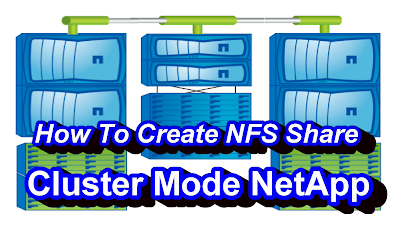How To Create NFS Share In SVM NetApp Cluster Mode
In this particular blog we will discuss how we can create NFS share in SVM NetApp cluster mode. NFS share are used in UNIX server to store data so that Unix user can perform various data operations such as read write and modification or even deletion. NFS Share in NetApp cluster mode belongs to SVM.
Steps To Create NFS Share In SVM NetApp Cluster Mode
There are four steps to create NFS share in SVM Netapp Cluster Mode. First step is to create volume with security style Unix. Second step is to create an export policy. Third step is to create a rule Under export policy. Fourth step is to assign the newly created export policy to the volume.
In this particular blog we will create NFS share by using command line approach.
Step 1 Create A Volume With Security Style Unix
Following command will create a volume with security style Unix of size of 30 MB. SVM name is vs1 and volume name is share1 the junction-path is /share1.
vol create -vserver vs1 -volume share1 -aggregate data_aggr01 -junction-path /share1 -size 30MB
Step 2 Create An Export Policy In SVM
Export policy is basically is combination of rules. These rules contains the access informations about UNIX server In which the NFS share will be mounted. Below command will create an export policy with name share1 in SVM vs1.
vserver export-policy create -vserver vs1 -policyname share1
Step 3 Create A Rule Under Export Policy
A rule in export policy contains the information about UNIX server such as its name or IP address what kind of access it requires and what protocol is going to use to access the data. Below is the command which will create a rule under share1
vserver export-policy rule create -vserver vs1 -policyname share1 -protocol any -clientmatch 192.168.15.173 -rorule any -rwrule any -superuser any
Step 4: Assign The Export Policy To The Volume Share1
This is the last step we need to perform. We need to modify volume’s export policy from default to the newly created export policy which is share1. we can do that by executing below command
volume modify -vserver vs1 -volume share1 -policy share1
We have completed all the steps which from Netapp end. Now we should give IP address or FQDN of SVM and the junction path of the volume to Unix administrator Unix administrator will use this information to mount the NFS Share. We need to provide the details in below format.
192.168.15.205:/share1
This concludes the discussion on how to create NFS share in SVM NetApp cluster mode. If you have any doubt or any knowledge to share please comment don't forget to subscribe our YouTube Channel And don't forget to share this blog as well.




